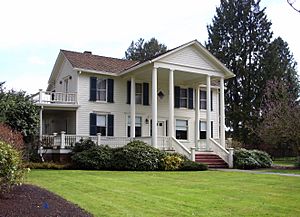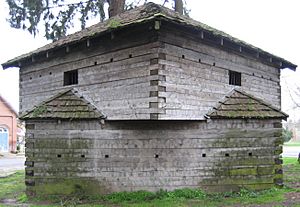Dayton, Oregon facts for kids
Quick facts for kids
Dayton, Oregon
|
|
|---|---|

|
|

Location in Oregon
|
|
| Country | United States |
| State | Oregon |
| County | Yamhill |
| Incorporated | 1880 |
| Area | |
| • Total | 0.84 sq mi (2.17 km2) |
| • Land | 0.84 sq mi (2.17 km2) |
| • Water | 0.00 sq mi (0.00 km2) |
| Elevation | 161 ft (49 m) |
| Population
(2020)
|
|
| • Total | 2,678 |
| • Density | 3,203.35/sq mi (1,236.55/km2) |
| Time zone | UTC-8 (Pacific) |
| • Summer (DST) | UTC-7 (Pacific) |
| ZIP code |
97114
|
| Area code(s) | 503 |
| FIPS code | 41-18250 |
| GNIS feature ID | 2410299 |
| Website | www.daytonoregon.gov |
Dayton is a small city located in Yamhill County, Oregon, in the United States. In 2020, about 2,678 people lived there. It's a friendly community with a rich history.
Contents
Exploring Dayton's Past
Dayton was started in 1850 by two people, Andrew Smith and Joel Palmer. Joel Palmer was also in charge of Native American affairs for Oregon at the time. He built a flour mill in the new settlement. The city was named after Andrew Smith's hometown, Dayton, Ohio. The first post office in Dayton opened in 1851.
Historic Buildings and Landmarks
Dayton has many old and important buildings. The oldest one still standing is the Joel Palmer House. It was built around 1852 or 1857. This house is so special that it was added to the National Register of Historic Places in 1987. It has been carefully fixed up and is now a popular restaurant.
Another important landmark is the Fort Yamhill Block House. It was moved to Dayton in 1911 to save it from being torn down. This blockhouse was built by settlers in 1855 and 1856 near the Grand Ronde Coastal Reservation. A citizen from Dayton, John G. Lewis, got permission to move the logs and rebuild it in Courthouse Square Park.
Where is Dayton Located?
Dayton is in the Willamette Valley of Oregon. It's about 25 miles (40 km) southwest of Portland, which is a much larger city. It's also about 7 miles (11 km) east of McMinnville.
The city covers a total area of about 0.84 square miles (2.17 square kilometers). All of this area is land, meaning there are no large lakes or rivers within the city limits.
How Many People Live in Dayton?
| Historical population | |||
|---|---|---|---|
| Census | Pop. | %± | |
| 1880 | 368 | — | |
| 1890 | 304 | −17.4% | |
| 1900 | 293 | −3.6% | |
| 1910 | 453 | 54.6% | |
| 1920 | 448 | −1.1% | |
| 1930 | 375 | −16.3% | |
| 1940 | 506 | 34.9% | |
| 1950 | 719 | 42.1% | |
| 1960 | 673 | −6.4% | |
| 1970 | 949 | 41.0% | |
| 1980 | 1,409 | 48.5% | |
| 1990 | 1,526 | 8.3% | |
| 2000 | 2,119 | 38.9% | |
| 2010 | 2,534 | 19.6% | |
| 2020 | 2,678 | 5.7% | |
| U.S. Decennial Census | |||
The population of Dayton has grown quite a bit over the years. In 1880, only 368 people lived there. By 2020, the population had reached 2,678 people.
Dayton's Community in 2010
According to the 2010 census, there were 2,534 people living in Dayton. Many families lived in the city, with almost half of the households having children under 18. The average household had about three people. The city's population was quite diverse, with people from many different backgrounds. The average age of residents was about 32.8 years old.
What Does Dayton Do for Work?
Dayton is a rural community, which means many people work in agriculture. They grow vegetables, berries, nuts, wheat, and nursery plants. Dairy farming is also important.
The Willamette Valley AVA and Dundee Hills AVA are famous for their vineyards and wineries. These businesses bring many visitors to Dayton and help the local economy grow.
Getting Around Dayton
Dayton is connected by several important roads. These are called state highways.
Main Highways in Dayton
- Oregon Route 18
- Oregon Route 221
- Oregon Route 233 (This road travels with State Route 18 for a part of its way.)
There is also an unsigned state highway:
- Oregon Route 154 (This road is also known as SE Lafayette Highway.)
Before some new roads were built, Highway 233 used to go right through downtown Dayton. It even crossed the Yamhill River by a ferry!
Learning in Dayton
Dayton has its own school system, called the Dayton School District. There are three schools for students:
- Dayton Grade School
- Dayton Middle School
- Dayton High School
The school mascot is the Pirate!
Famous People from Dayton
Some well-known people have come from Dayton:
- Dante Rosario – an NFL player
- Dewey Sullivan – a famous football coach at Dayton High School, who is in the Oregon Sports Hall of Fame
- Paige VanZant – a UFC fighter
See also
 In Spanish: Dayton (Oregón) para niños
In Spanish: Dayton (Oregón) para niños


